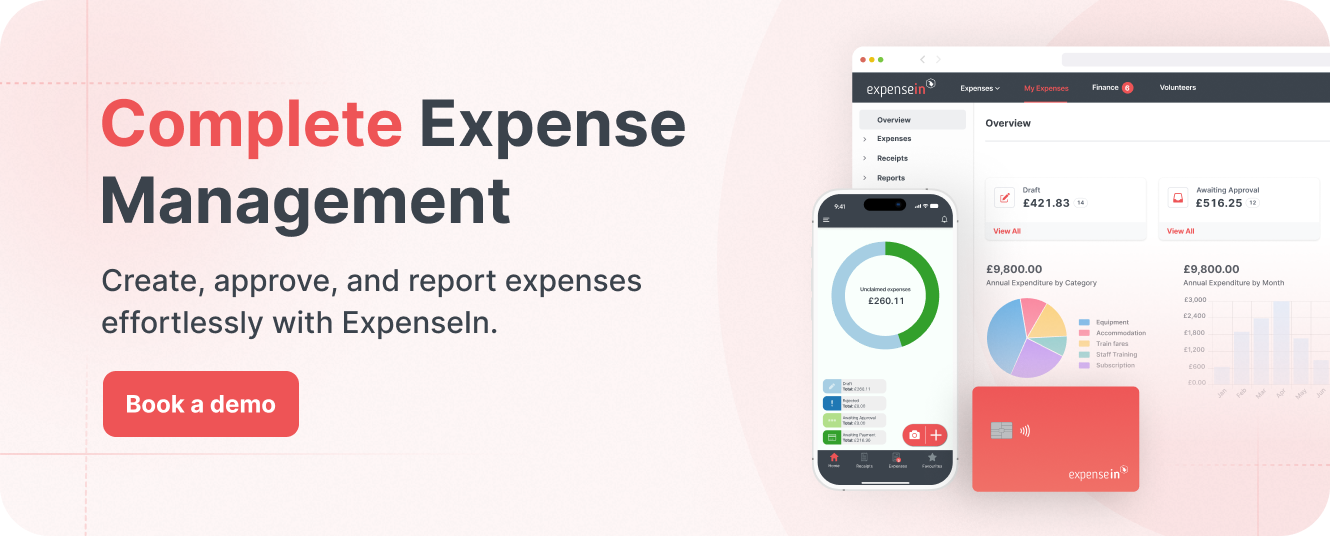If you run Finance in the UK or Ireland, you already know the pressure is mounting. Costs are rising, HMRC scrutiny is tight, and your team is spending too much time chasing missing receipts and correcting claims.
In fact, 1 in 10 employees is contacted daily just for missing receipts, and nearly 30% are chased weekly – an invisible time drain that erodes morale, blocks VAT reclaims and quietly leaks budget.

The reality is that most expense policy breaches aren’t elaborate fraud. They’re everyday slip-ups: the rounded-up mileage claim, the “business” dinner with family members, the forgotten VAT invoice. Left unchecked, these small violations add up to big compliance risks.
This guide unpacks the seven most common expense policy violations UK finance teams face and the HMRC-aligned controls that stop them before they become expensive problems.
Quick summary: What to implement this quarter
Write it down, make it real: Update your expense policy with clear examples of allowable vs. non-allowable spend, and require employees to confirm their claims are accurate.
Enforce in real time: Use automated rules, category blocks, spend caps, and duplicate detection before money leaves the business.
Protect VAT: Refuse claims without valid VAT receipts. Train managers on what a compliant invoice looks like.
Fix the mileage gap: Replace estimates with verified GPS or point-to-point routes. Align payments with HMRC rates.
Make receipts effortless: Encourage instant capture with a mobile expense app. Integrate e-receipts where possible.
Need a starting point? Download our free Expense Policy Template to save time drafting clear rules and examples.
The Violation | Controls That Work |
|---|---|
Personal spend disguised as business | Clear policy examples + card category blocks |
Inflated mileage/claims | GPS or point-to-point mileage + require receipts + flag outliers |
Fake or altered receipts | OCR receipt checks + itemised invoices only + random audits |
Duplicate claims | Single system for card + reimbursement + auto-match |
Overspending limits | Built-in caps + card-level limits + pre-approvals for exceptions |
Out-of-policy purchases | Explicit non-allowables + MCC blocks + 2-step approvals for risky spend |
Missing receipts | Mobile-first capture + auto e-receipts |
1. Personal expenses disguised as business costs
What you’ll see:
“Office supplies” that look suspiciously like home goods
“Client meals” with family attendees
Lifestyle purchases on a corporate expense card
In the UK, 24% of employees admitted to passing off personal spend as business expenses during the cost-of-living crisis.
HMRC’s rule still stands: claims must be “wholly and exclusively” for business.
Controls that work:
Crystal-clear policy with examples of prohibited claims (family travel, spa days, personal gifts).
Short justifications for corporate travel and business entertainment, including attendees and purpose.
Card-level blocks and alerts for luxury or inappropriate spend categories.
Consistent consequences for violations – clawbacks and escalation for repeat offences.
Reality check: CFOs regularly report eyebrow-raising submissions, from luxury leisure breaks to “creative” client gifts. Don’t assume employees know where the line is. Make it clear.
2. Inflated or exaggerated claims
What you’ll see:
Rounded-up mileage (“50 miles” for a 42-mile trip)
Taxi fares rounded up or padded
“Per diems” that always hit the cap
Research shows 1 in 4 UK employees exaggerate expense claims. Left unchecked, exaggeration quickly becomes a team-wide habit.
Controls that work:
Evidence by default: Receipts for everything above a set threshold; routes or GPS for mileage.
Automate mileage: Calculate exact journeys using HMRC MAPs and AFRs.
Outlier detection: Flag claims that significantly exceed peer averages.
Micro-training: Onboarding refreshers and quarterly reminders on what “accurate” looks like.
Mileage claims must follow HMRC’s Mileage Allowance Payments (MAPs) for private cars and Advisory Fuel Rates (AFRs) for company cars. Review and update your rates quarterly to stay compliant and stop padding at the source.
3. Fake or altered receipts
What you’ll see:
Photoshopped amounts or dates
Re-used receipts submitted more than once
PDFs that don’t match known merchant formats
Expense fraud like this can slip through for months if finance is relying on paper-based or manual checks.
Controls that work:
OCR + validation: Automatically extract and verify VAT, merchant, and date from receipts.
Itemised invoices only: Not just card statements.
Random audits: Phone a hotel or verify a VAT number occasionally.
Zero tolerance: Make submitting falsified documentation a gross misconduct offence.
4. Duplicate claims and double-dipping
What you’ll see:
A dinner charged to a business expense card and claimed as out-of-pocket
Two colleagues each expensing the same shared cost
Duplicates often happen when finance processes are siloed or spreadsheet-based.
Controls that work:
Single system of record: Corporate expense cards and expense reimbursements in one place.
Same-day matching of receipts to card feeds.
Manager coaching on spotting duplicate dates/amounts/merchants.
5. Blowing past limits and budgets
What you’ll see:
Five-star hotels where the policy caps at £150/night
Premium flights booked “due to availability”
Without real-time checks, finance only catches overspend after the money’s gone.
Controls that work:
Built-in caps: Auto-block or require justification notes before submission.
Card-level limits: Restrict premium classes unless pre-approved.
Pre-trip approvals for high-risk or high-value spend.
6. Out-of-policy categories (unauthorised purchases)
What you’ll see:
First-class upgrades
High alcohol spend
“Client entertainment” in inappropriate venues
Personal gifts disguised as business development
These are financial compliance and reputational risks, not just cost leak.
Controls that work:
Explicit non-allowables: List prohibited categories and edge cases.
Merchant Category Code (MCC) blocks: Decline purchases at restricted merchants.
Two-step approvals for entertainment/gifts above a certain value.
Struggling with grey areas in your own policy? Grab our free Expense Policy Template! It spells out allowable vs non-allowable spend clearly for employees.
7. Missing receipts and weak documentation
What you’ll see:
Lost paper receipts
Illegible photos
Card statements submitted instead of invoices
HMRC requires valid VAT invoices to reclaim input tax. Card statements alone won’t cut it.
Controls that work:
Mobile-first capture: Snap at point of purchase; automate reminders.
“No receipt, no reimbursement” (with very limited exceptions).
Auto-collect e-receipts from travel providers and card feeds.
How ExpenseIn helps you enforce this (without adding workload)
ExpenseIn bakes these controls into daily workflows, so Finance prevents leakage instead of chasing it. 
Automated policy rules & advanced approvals stop breaches before submission.
Expense cards + reimbursements in one place with duplicate detection and MCC/spend controls.
OCR & VAT validation ensures every claim has valid documentation.
Mileage automation verifies routes and automatically applies HMRC rates.
If you’re still relying on spreadsheets or fragmented tools, the fastest win is to unify processes and controls.
You’ll cut leakage, speed up reimbursements, and free your finance team from detective work.
 Frequently asked questions on expense policy violations
Frequently asked questions on expense policy violations
Here are quick answers to the most common compliance questions UK finance teams face:
An expense policy violation happens when an employee submits a claim that breaches company policy or HMRC rules.
Common examples include:
Submitting personal purchases (e.g. holidays, spa days) as business costs
Inflating mileage or taxi fares
Failing to provide a valid VAT receipt
Claiming the same cost twice (double-dipping)
Overspending beyond company-set limits
No. HMRC requires a valid VAT invoice showing the:
Supplier’s details
VAT registration number
Date
VAT breakdown
A card statement alone is not sufficient. Without a valid invoice, businesses risk losing the VAT reclaim.
The most effective way is to automate mileage tracking.
Instead of relying on employee estimates, use GPS or point-to-point calculations and reimburse only at HMRC’s MAPs or AFRs. This ensures claims are both consistent and compliant.
Non-allowables are costs that are not “wholly and exclusively” for business. Examples include:
Personal gifts or leisure activities
First-class travel without pre-approval
Alcohol-heavy entertainment
Family travel or add-on holiday costs during business trips
Every company should list non-allowables explicitly in its policy to avoid grey areas.
Duplicate claims often occur when:
The same expense is submitted both as a card payment and as an out-of-pocket claim
Two employees split an expense (e.g. hotel room), but both claim the full amount
An old receipt is reused across different reports
Centralising business expense cards and reimbursements in one expense management system is the simplest way to prevent this.
If a valid VAT invoice is missing, the business may lose the VAT reclaim. Missing receipts also slow down approvals and increase audit risks.
Best practice is to enforce “no receipt, no reimbursement” (with limited exceptions) and make receipt capture effortless with a mobile expense app.
Finance leaders should review expense policies at least once a year or sooner if:
HMRC updates mileage rates or VAT rules
The company introduces new corporate cards
There are shifts in travel, hybrid working, or spending patterns
Regular reviews ensure policies stay relevant and enforceable.
Modern expense management solutions can:
Block non-allowable spend at the point of purchase with card-level controls
Flag duplicates and outliers in real time
Automate VAT validation and ensure receipts are attached before submission
Simplify compliance by embedding policies into employee workflows
This reduces errors, prevents fraud, and saves finance teams hours of manual checks.



